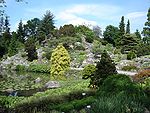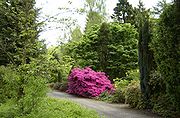
Utrecht University Botanic Gardens
Encyclopedia


Uithof
De Uithof is the campus area of the Utrecht University and the University of Professional Education Utrecht. It is located on the east of Utrecht, near the Galgenwaard Stadium of FC Utrecht. Except for the faculties of Law, Humanities, and University College, which are located in the inner city of...
and the Von Gimborn Arboretum
Von Gimborn Arboretum
Von Gimborn Arboretum is a large living collection of woody plants in the Netherlands, which makes part of the Botanical Gardens of Utrecht University. The arboretum is situated in Doorn, province of Utrecht, about 25 km to the east from the city of Utrecht, and together with its nursery...
in Doorn
Doorn
Doorn is a town in the municipality of Utrechtse Heuvelrug in the central Netherlands, in the province of Utrecht. On 1 January 2008 the town had 10,052 inhabitants.-History:...
.
However, the history of living plant collections of Utrecht University
Utrecht University
Utrecht University is a university in Utrecht, Netherlands. It is one of the oldest universities in the Netherlands and one of the largest in Europe. Established March 26, 1636, it had an enrollment of 29,082 students in 2008, and employed 8,614 faculty and staff, 570 of which are full professors....
dates back to the 17th century. The first botanical garden
Botanical garden
A botanical garden The terms botanic and botanical, and garden or gardens are used more-or-less interchangeably, although the word botanic is generally reserved for the earlier, more traditional gardens. is a well-tended area displaying a wide range of plants labelled with their botanical names...
of the university was founded in Utrecht
Utrecht (city)
Utrecht city and municipality is the capital and most populous city of the Dutch province of Utrecht. It is located in the eastern corner of the Randstad conurbation, and is the fourth largest city of the Netherlands with a population of 312,634 on 1 Jan 2011.Utrecht's ancient city centre features...
in 1639, three years after the establishment of the university itself. Around 1723 the collection moved to another location within the old city, which still exists as the museum garden of the University Museum, known as Oude Hortus (old garden). It is the place where around 1730 Ginkgo biloba was planted for the first time in Europe. In 1920 Cantonspark in Baarn
Baarn
Baarn is a municipality and a town in the Netherlands, in the province of Utrecht.-The municipality Baarn :The municipality of Baarn consists of the following towns: Baarn, Eembrugge, Lage Vuursche.- The town Baarn :...
became another part of the university gardens, with a rock garden
Rock Garden
The Rock Garden or Rock Garden of Chandigarh is a Sculpture garden in Chandigarh, India, also known as Nek Chand's Rock Garden after its founder Nek Chand, a government official who started the garden secretly in his spare time in 1957. Today it is spread over an area of forty-acres , it is...
and thematic beds. In 1963 Utrecht University acquired the land at Fort Hofddijk, one of the forts of the New Dutch Waterline, situated in Uithof, the modern campus of the university on the eastern outskirts of the city of Utrecht. In 1964 the university bought the Sandwijck buitenplaats
Buitenplaats
A buitenplaats was a summer residence for rich townspeople in the Netherlands. During the Dutch Golden Age of the 17th century, many traders and city administrators in Dutch towns became very wealthy...
in De Bilt
De Bilt
De Bilt is a municipality and a town in the Netherlands, in the province of Utrecht.-Population centres :The municipality of De Bilt consists of the following cities, towns, villages and/or districts: Bilthoven, De Bilt, Groenekan, Hollandsche Rading, Maartensdijk, Westbroek...
, where greenhouses and a nursery were organized, and in 1966 it acquired Von Gimborn Arboretum in Doorn. In 1964-1974 the rocks from the old rock garden in Cantonspark and additional 2100 t of rocks from Ardennes
Ardennes
The Ardennes is a region of extensive forests, rolling hills and ridges formed within the Givetian Ardennes mountain range, primarily in Belgium and Luxembourg, but stretching into France , and geologically into the Eifel...
were laid on the top of Fort Hoofddijk in order to build the new rock garden, which has become one of the largest in Europe. In the 1970s systematic beds were laid down there as well, and in the 1980s the new complex of greenhouses was constructed. In 1987 the collections of Oude Hortus, Cantonspark and Sandwijck were transferred to Fort Hoofddijk, which thus became the main location of the botanical gardens.

